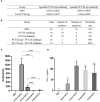Epidemiological Analysis From 2018 to 2020 in China and Prevention Strategy of Porcine Circovirus Type 2
- PMID: 34869727
- PMCID: PMC8635018
- DOI: 10.3389/fvets.2021.753297
Epidemiological Analysis From 2018 to 2020 in China and Prevention Strategy of Porcine Circovirus Type 2
Abstract
Porcine circovirus type 2 (PCV2) is one of the smallest known animal viruses and is the main pathogen of PCV-associated diseases (PCVAD). Epidemiological surveillance results have shown that the PCV2 infection rate is on the rise in China, thus, PCV2 disease prevention and control has become a huge challenge for the Chinese swine industry. We collected clinical samples from multiple different provinces in China from 2018 to 2020 and found that the positive rate of PCV2 was 53% (3619/6872), identity between the cloned 62 ORF2 genes was 84.4-100% and identity between the cloned 62 ORF2 sequences and reference sequence was 72.9-99.8%. Genetic evolution analysis found that PCV2d accounted for 79% (49/62 samples), PCV2a for 12.9% (8/62 samples), PCV2b for 8% (5/62 samples), and PCV2c and PCV2e genotypes were not found. However, most commercial PCV2 subunit vaccines are based on the PCV2a genotype, and there are very few vaccines based on PCV2b or PCV2d. Therefore, the homologous and heterologous protection ability of PCV2b and PCV2d Cap proteins based on the baculovirus against the PCV2b and PCV2d infections was evaluated, which is expected to design and develop excellent PCV2 protein vaccine candidates. This study found that both PCV2b and PCV2d Cap proteins can increase the level of humoral immunity and cellular immune response in mice. Importantly, both PCV2b and PCV2d cap proteins can provide homologous and heterologous protection against the PCV2b and PCV2d viruses. Overall, this study provides a reference for the prevention and control of PCVAD in mainland China and the development of PCV2 vaccines.
Keywords: PCV2b Cap; PCV2d Cap; epidemiological analysis; heterologous protection; homologous protection.
Copyright © 2021 Huang, Chen, Long, Yang, Song, Liu, Li, Liang, Yu, Huang and Tang.
Conflict of interest statement
All authors are employed by Wuhan Keqian Biology Co., Ltd.
Figures







Similar articles
-
Porcine circovirus type 2a or 2b based experimental vaccines provide protection against PCV2d/porcine parvovirus 2 co-challenge.Vaccine. 2020 Feb 18;38(8):1975-1981. doi: 10.1016/j.vaccine.2020.01.013. Epub 2020 Jan 20. Vaccine. 2020. PMID: 31974016
-
Genetic Diversity and Prevalence of Porcine Circovirus Type 2 in China During 2000-2019.Front Vet Sci. 2021 Dec 15;8:788172. doi: 10.3389/fvets.2021.788172. eCollection 2021. Front Vet Sci. 2021. PMID: 34977219 Free PMC article.
-
The prevalence of porcine circovirus type 2e (PCV2e) in Korean slaughter pig lymph nodes when compared with other PCV2 genotypes.Transbound Emerg Dis. 2021 Nov;68(6):3043-3047. doi: 10.1111/tbed.13975. Epub 2021 Jan 17. Transbound Emerg Dis. 2021. PMID: 33406315
-
Porcine Circovirus Type 2 (PCV2) Vaccines in the Context of Current Molecular Epidemiology.Viruses. 2017 May 6;9(5):99. doi: 10.3390/v9050099. Viruses. 2017. PMID: 28481275 Free PMC article. Review.
-
Revisiting Porcine Circovirus Infection: Recent Insights and Its Significance in the Piggery Sector.Vaccines (Basel). 2023 Jul 31;11(8):1308. doi: 10.3390/vaccines11081308. Vaccines (Basel). 2023. PMID: 37631876 Free PMC article. Review.
Cited by
-
Virome of wild rats (Rattus norvegicus) captured far from pig farms in Jiangsu province of China reveals novel porcine circovirus type 2d (PCV2d) sequences.Virol J. 2023 Mar 9;20(1):46. doi: 10.1186/s12985-023-02005-2. Virol J. 2023. PMID: 36894948 Free PMC article.
-
Isolation and pathogenicity of porcine circovirus type 2 in mice from Guangxi province, China.Virol J. 2023 Aug 29;20(1):195. doi: 10.1186/s12985-023-02161-5. Virol J. 2023. PMID: 37644571 Free PMC article.
-
The Prevalence and Genetic Diversity of Porcine Circoviruses (PCVs) during 2017-2023 in Guangdong Province, China.Animals (Basel). 2023 Nov 24;13(23):3640. doi: 10.3390/ani13233640. Animals (Basel). 2023. PMID: 38066990 Free PMC article.
-
Pathogenic ecological characteristics of PCV2 in large-scale pig farms in China affected by African swine fever in the surroundings from 2018 to 2021.Front Microbiol. 2023 Jan 4;13:1013617. doi: 10.3389/fmicb.2022.1013617. eCollection 2022. Front Microbiol. 2023. PMID: 36687656 Free PMC article.
-
Prevalence and genetic diversity of porcine circovirus type 2 in northern Guangdong Province during 2016-2021.Front Vet Sci. 2022 Aug 10;9:932612. doi: 10.3389/fvets.2022.932612. eCollection 2022. Front Vet Sci. 2022. PMID: 36032297 Free PMC article.
References
LinkOut - more resources
Full Text Sources
Miscellaneous

